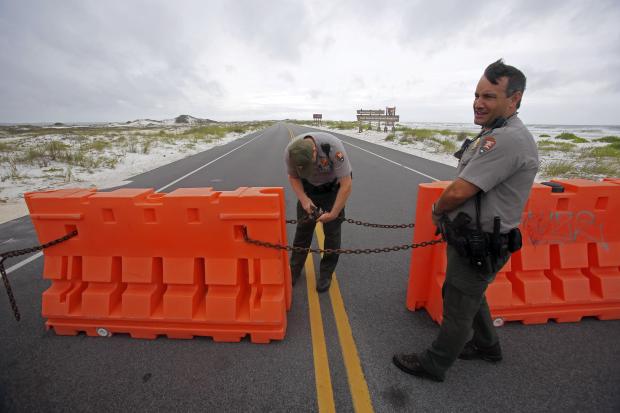
Rangers with the the National Park Service close off the Highway 399 through Gulf Islands National Seashore as a subtropical storm makes landfall on Monday, May 28, 2018 in Pensacola, Florida. (Photo by DAN ANDERSON / AP)
Alberto is a still-menacing depression after its Memorial Day landfall on the Gulf Coast, scattering heavy rains around the South and raising risks of flash floods.
As the first named storm of the 2018 Atlantic hurricane season, Subtropical Storm Alberto lumbered ashore Monday afternoon in the Florida Panhandle and then weakened overnight to a depression centered over Alabama. Now it’s a vast, soggy system dumping the warm water it gathered over the Gulf of Mexico in bursts of rain across the southeast.
Forecasters said that rain could still kill people caught in flash floods in the coming hours or days in Alabama and large areas of Georgia, Tennessee and the Carolinas.
In North Carolina, a television news anchor and a photojournalist were killed instantly on Monday while covering the weather, when a tree became uprooted from rain-soaked ground and toppled onto their SUV, authorities said.
“Two journalists working to keep the public informed about this storm have tragically lost their lives, and we mourn with their families, friends and colleagues,” North Carolina Gov. Roy Cooper said in a statement.
“North Carolina needs to take Alberto seriously. I urge everyone to keep a close eye on forecasts, warnings and road conditions, especially in western North Carolina where even heavier rain is predicted.”
Between 2 and 8 inches (10-25 centimeters) of rain could soak Alabama and western Georgia on Tuesday, and isolated deluges of 12 inches (30 centimeters) also are possible as the system heads into the Tennessee Valley on its way to the Ohio Valley and Great Lakes region.
Alberto dumped between 2 and 5 inches (2 and 13 centimeters) of rain over parts of the Florida Panhandle, according to the National Weather Service. Double-red flags along the white sandy beaches kept most people out of the rough waters, and some low-lying areas experienced minor flooding, officials said.
“Most of the issues we’re having right now are downed trees and downed limbs,” Walton County spokesman Louis Svehla told the Northwest Florida Daily News. “Our beaches did good. There was not a lot of erosion. The surge was not that large.”
Santa Rosa County officials had put out many piles of sand several days ago in case people wanted to mitigate any flooding in their homes. People who took those supplies will be better prepared as the hurricane season gets its official start on Friday, said county spokeswoman Brandi Whitehurst.
“What Alberto has done for us is to have people dust off their hurricane plans and stock up on supplies,” Whitehurst said.
The pelting rain soaked the uniform and socks of Lt. Andy Husar with the Bay County Sheriff’s Office, who watched surf get kicked up along Panama City Beach on Monday.
“It’s not a good sign, getting hit by a storm before hurricane season,” Husar told the Panama City News Herald.
As a subtropical storm, Alberto had a less defined and cooler center than a tropical storm, and its strongest winds were found farther from its center.
The large tree that crushed the TV news vehicle Monday afternoon near Tryon, North Carolina, killed news anchor Mike McCormick and photojournalist Aaron Smeltzer of WYFF-TV of Greenville, South Carolina, the station said.
They had just interviewed Tryon Fire Chief Geoffrey Tennant as they covered storms in North Carolina.
“Ten minutes later we get the call and it was them,” Tennant said at a news conference, his voice cracking.
Tennant said the roots of the large tree tore loose from ground saturated by a week’s worth of rain. The men died instantly, their vehicle’s engine still running, he said.